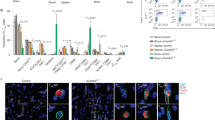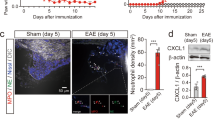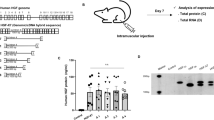Abstract
We recently described a non-viral gene therapy paradigm offering long-term resolution of established neuropathic pain in several animal models. Here, the requirements for long-term therapeutic effects are described, and evidence is provided for a mechanism of action based on immunological priming of the intrathecal (i.t.) space. Long-term pain reversal was achieved when two i.t. injections of various naked plasmid DNA doses were separated by 5 h to 3 days. We show that an initial DNA injection, regardless of whether a transgene is included, leads to an accumulation of phagocytic innate immune cells. This accumulation coincides with the time in which subsequent DNA injection efficacy is potentiated. We show the ability of non-coding DNA to induce short-term pain reversal that is dependent on endogenous interleukin-10 (IL-10) signaling. Long-term efficacy requires the inclusion of an IL-10F129S transgene in the second injection. Blockade of IL-10, by a neutralizing antibody, either between the two injections or after the second injection induces therapeutic failure. These results show that this gene therapy paradigm uses an initial ‘priming’ injection of DNA to induce accumulation of phagocytic immune cells, allowing for potentiated efficacy of a subsequent ‘therapeutic’ DNA injection in a time- and dose-dependent manner.
This is a preview of subscription content, access via your institution
Access options
Subscribe to this journal
Receive 12 print issues and online access
$259.00 per year
only $21.58 per issue
Buy this article
- Purchase on Springer Link
- Instant access to full article PDF
Prices may be subject to local taxes which are calculated during checkout








Similar content being viewed by others
References
Azzam T, Domb AJ . Current developments in gene transfection agents. Curr Drug Deliv 2004; 1: 165–193.
Boulaiz H, Marchal JA, Prados J, Melguizo C, Aránega A . Non-viral and viral vectors for gene therapy. Cell Mol Biol 2005; 51: 3–22.
Grønevik E, von Steyern FV, Kalhovde JM, Tjelle TE, Mathiesen I . Gene expression and immune response kinetics using electroporation-mediated DNA delivery to muscle. J Gene Med 2005; 7: 218–227.
George JS . Gene therapy progress and prospects: adenoviral vectors. Gene Therapy 2003; 10: 1135–1141.
Driesse MJ, Esandi MC, Kros JM, Avezaat CJ, Vecht C, Zurcher C et al. Intra-CSF administered recombinant adenovirus causes an immune response-mediated toxicity. Gene Therapy 2000; 7: 1401–1409.
Zaiss A, Muruve D . Immune responses to adeno-associated virus vectors. Curr Gene Ther 2005; 5: 323–331.
Hu P, Bembrick AL, Keay KA, McLachlan EM . Immune cell involvement in dorsal root ganglia and spinal cord after chronic constriction or transection of the rat sciatic nerve. Brain Behav Immun 2007; 21: 599–616.
Durrenberger PF, Facer P, Casula MA, Yiangou Y, Gray RA, Chessell IP et al. Prostanoid receptor EP1 and Cox-2 in injured human nerves and a rat model of nerve injury: a time-course study. BMC Neurol 2006; 6: 1.
Ohtori S, Takahashi K, Moriya H, Myers RR . TNF-alpha and TNF-alpha receptor type 1 upregulation in glia and neurons after peripheral nerve injury: studies in murine DRG and spinal cord. Spine 2004; 29: 1082–1088.
Peters CM, Ghilardi JR, Keyser CP, Kubota K, Lindsay TH, Luger NM et al. Tumor-induced injury of primary afferent sensory nerve fibers in bone cancer pain. Exp Neurol 2005; 193: 85–100.
McNicol E, Horowicz-Mehler N, Fisk RA, Bennett K, Gialeli-Goudas M, Chew PW et al. Management of opioid side effects in cancer-related and chronic noncancer pain: a systematic review. J Pain 2003; 4: 231–256.
Watkins L, Maier S . Glia: a novel drug discovery target for clinical pain. Nat Rev Drug Discov 2003; 2: 973–985.
Watkins L, Milligan E, Maier S . Glial proinflammatory cytokines mediate exaggerated pain states: implications for clinical pain. Adv Exp Med Biol 2003; 521: 1–21.
Tsuda M, Inoue K, Salter M . Neuropathic pain and spinal microglia: a big problem from molecules in ‘small’ glia. Trends Neurosci 2005; 28: 101–107.
Milligan ED, Twining C, Chacur M, Biedenkapp J, O'Connor K, Poole S et al. Spinal glia and proinflammatory cytokines mediate mirror-image neuropathic pain in rats. J Neurosci 2003; 23: 1026–1040.
McMahon S, Cafferty W, Marchand F . Immune and glial cell factors as pain mediators and modulators. Exp Neurol 2005; 192: 444–462.
Zhou Z, Peng X, Hao S, Fink DJ, Mata M . HSV-mediated transfer of interleukin-10 reduces inflammatory pain through modulation of membrane tumor necrosis factor alpha in spinal cord microglia. Gene Therapy 2008; 15: 183–190.
Marques CP, Hu S, Sheng W, Cheeran MC, Cox D, Lokensgard JR . Interleukin-10 attenuates production of HSV-induced inflammatory mediators by human microglia. Glia 2004; 47: 358–366.
Plunkett J, Yu CG, Easton JM, Bethea JR, Yezierski RP . Effects of interleukin-10 (IL-10) on pain behavior and gene expression following excitotoxic spinal cord injury in the rat. Exp Neurol 2001; 168: 144–154.
Strle K, Zhou JH, Shen WH, Broussard SR, Johnson RW, Freund GG et al. Interleukin-10 in the brain. Crit Rev Immunol 2001; 21: 427–449.
Milligan ED, Langer SJ, Sloane EM, He L, Wieseler-Frank J, O'Connor K et al. Controlling pathological pain by adenovirally driven spinal production of the anti-inflammatory cytokine, interleukin-10. Eur J Neurosci 2005; 21: 2136–2148.
Milligan ED, Sloane EM, Langer SJ, Cruz PE, Chacur M, Spataro L et al. Controlling neuropathic pain by adeno-associated virus driven production of the anti-inflammatory cytokine, interleukin-10. Mol Pain 2005; 1: 9.
Milligan ED, Sloane EM, Langer SJ, Hughes TS, Jekich BM, Frank MG et al. Repeated intrathecal injections of plasmid DNA encoding interleukin-10 produce prolonged reversal of neuropathic pain. Pain 2006; 126: 294–308.
Mu W, Ouyang X, Agarwal A, Zhang L, Long DA, Cruz PE et al. IL-10 suppresses chemokines, inflammation, and fibrosis in a model of chronic renal disease. J Am Soc Nephrol 2005; 16: 3651–3660.
Chen S, Kapturczak MH, Wasserfall C, Glushakova OY, Campbell-Thompson M, Deshane JS et al. Interleukin 10 attenuates neointimal proliferation and inflammation in aortic allografts by a heme oxygenase-dependent pathway. Proc Natl Acad Sci USA 2005; 102: 7251–7256.
Storek B, Reinhardt M, Wang C, Janssen WG, Harder NM, Banck MS et al. Sensory neuron targeting by self-complementary AAV8 via lumbar puncture for chronic pain. Proc Natl Acad Sci USA 2008; 105: 1055–1060.
Sloane E, Ledeboer A, Seibert W, Coats B, van Strien M, Maier SF et al. Anti-inflammatory cytokine gene therapy decreases sensory and motor dysfunction in experimental multiple sclerosis: MOG-EAE behavioral and anatomical symptom treatment with cytokine gene therapy. Brain Behav Immun 2000; 23: 92–100.
Zanella JM, Burright EN, Hildebrand K, Hobot C, Cox M, Christoferson L et al. Effect of etanercept, a tumor necrosis factor-alpha inhibitor, on neuropathic pain in the rat chronic constriction injury model. Spine 2008; 33: 227–234.
Dong X-W, Goregoaker S, Engler H, Zhou X, Mark L, Crona J et al. Small interfering RNA-mediated selective knockdown of Nav1.8 tetrodotoxin-resistant sodium channel reverses mechanical allodynia in neuropathic rats. Neuroscience 2007; 146: 812–821.
Sharp CJ, Reeve AJ, Collins SD, Martindale JC, Summerfield SG, Sargent BS et al. Investigation into the role of P2X(3)/P2X(2/3) receptors in neuropathic pain following chronic constriction injury in the rat: an electrophysiological study. Br J Pharmacol 2006; 148: 845–852.
Verge GM, Milligan ED, Maier SF, Watkins LR, Naeve GS, Foster AC . Fractalkine (CX3CL1) and fractalkine receptor (CX3CR1) distribution in spinal cord and dorsal root ganglia under basal and neuropathic pain conditions. Eur J Neurosci 2004; 20: 1150–1160.
Lee HL, Lee KM, Son SJ, Hwang SH, Cho HJ . Temporal expression of cytokines and their receptors mRNAs in a neuropathic pain model. Neuroreport 2004; 15: 2807–2811.
Schäfers M, Geis C, Svensson CI, Luo ZD, Sommer C . Selective increase of tumour necrosis factor-alpha in injured and spared myelinated primary afferents after chronic constrictive injury of rat sciatic nerve. Eur J Neurosci 2003; 17: 791–804.
Okamoto K, Martin DP, Schmelzer JD, Mitsui Y, Low PA . Pro- and anti-inflammatory cytokine gene expression in rat sciatic nerve chronic constriction injury model of neuropathic pain. Exp Neurol 2001; 169: 386–391.
Wagner R, Janjigian M, Myers RR . Anti-inflammatory interleukin-10 therapy in CCI neuropathy decreases thermal hyperalgesia, macrophage recruitment, and endoneurial TNF-α expression. Pain 1998; 74: 35–42.
Milligan ED, Langer SJ, Sloane EM, He L, Wieseler-Frank J, O'Connor K et al. Controlling pathological pain by adenovirally driven spinal production of the anti-inflammatory cytokine, interleukin-10. Eur J Neurosci 2005; 21: 2136–2148.
Watkins LR, Hansen MK, Nguyen KT, Lee JE, Maier SF . Dynamic regulation of the proinflammatory cytokine, interleukin-1β: molecular biology for non-molecular biologists. Life Sci 1999; 65: 449–481.
Matzinger P . Essay 1: the danger model in its historical context. Scand J Immunol 2001; 54: 4–9.
Matzinger P . Tolerance, danger, and the extended family. Ann Rev Immunol 1994; 12: 991–1045.
Janeway CA, Travers P, Walport M, Shlomchik MJ . Immunobiology: The Immune System in Health and Disease, 6th edn. Garland Science Publishing: New York, NY, 2005.
Akira S, Takeda K . Toll-like receptor signalling. Nat Rev Immunol 2004; 4: 499–511.
Parker L, Prince L, Sabroe I . Translational mini-review series on toll-like receptors: networks regulated by toll-like receptors mediate innate and adaptive immunity. Clin Exp Immunol 2007; 147: 199–207.
Ghosh TK, Mickelson DJ, Fink J, Solberg JC, Inglefield JR, Hook D et al. Toll-like receptor (TLR) 2-9 agonists-induced cytokines and chemokines: I. Comparison with T cell receptor-induced responses. Cell Immunol 2006; 243: 48–57.
Yasuda K, Kawano H, Yamane I, Ogawa Y, Yoshinaga T, Nishikawa M et al. Restricted cytokine production from mouse peritoneal macrophages in culture in spite of extensive uptake of plasmid DNA. Immunology 2004; 111: 282–290.
Braun J, Brigitte K, Hir ML, Zenker W . Cellular components of the immune barrier in the spinal meninges and dorsal root ganglia of the normal rat: immunohistochemical (MHC class II) and electron-microscopic observations. Cell Tissue Res 1993; 273: 209–217.
McMenamin PG, Wealthall RJ, Deverall M, Cooper SJ, Griffin B . Macrophages and dendritic cells in the rat meninges and choroid plexus: three-dimensional localization by environmental scanning electron microscopy and confocal microscopy. Cell Tissue Res 2003; 313: 259–269.
Masuda A, Yoshikai Y, Aiba K, Matsuquchi T . Th2 cytokine production from mast cells is directly induced by lipopolysaccharide and distincly regulated by c-Jun N-terminal kinase and p38 pathways. J Immunol 2002; 169: 3801–3810.
Ajuebor MN, Das AM, Virág L, Flower RJ, Szabó C, Perretti M . Role of resident peritoneal macrophages and mast cells in chemokine production and neutrophil migration in acute inflammation: evidence for an inhibitory loop involving endogenous IL-10. J Immunol 1999; 162: 1685–1691.
Fickenscher H, Hör S, Küpers H, Knappe A, Wittmann S, Sticht H . The interleukin-10 family of cytokines. Trends Immunol 2002; 23: 89–96.
Martinez F, Sica A, Mantovani A, Locati M . Macrophage activation and polarization. Front Biosci 2008; 13: 453–461.
Fabriek B, Dijkstra C, Berg Tvd . The macrophage scavenger receptor CD163. Immunobiology 2005; 210: 153–160.
Milligan ED, O'Connor KA, Nguyen KT, Armstrong CB, Twining C, Gaykema RP et al. Intrathecal HIV-1 envelope glycoprotein gp120 induces enhanced pain states mediated by spinal cord proinflammatory cytokines. J Neurosci 2001; 21: 2808–2819.
Hartmann B, Ahmadi S, Heppenstall PA, Lewin GR, Schott C, Borchardt T et al. The AMPA receptor subunits GluR-A and GluR-B reciprocally modulate spinal synaptic plasticity and inflammatory pain. Neuron 2004; 44: 637–650.
Acknowledgements
Financial support to this work is provided by Avigen and the NIH grants DA018156, DA015642, DA015656 and HL5510.
Author information
Authors and Affiliations
Corresponding author
Additional information
This work was conducted at the University of Colorado, Boulder, CO, USA.
Supplementary Information accompanies the paper on Gene Therapy website (http://www.nature.com/gt)
Rights and permissions
About this article
Cite this article
Sloane, E., Langer, S., Jekich, B. et al. Immunological priming potentiates non-viral anti-inflammatory gene therapy treatment of neuropathic pain. Gene Ther 16, 1210–1222 (2009). https://doi.org/10.1038/gt.2009.79
Received:
Revised:
Accepted:
Published:
Issue Date:
DOI: https://doi.org/10.1038/gt.2009.79
Keywords
This article is cited by
-
Long-term control of neuropathic pain in a non-viral gene therapy paradigm
Gene Therapy (2009)



